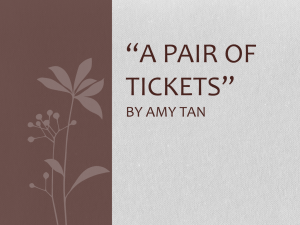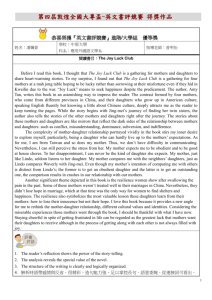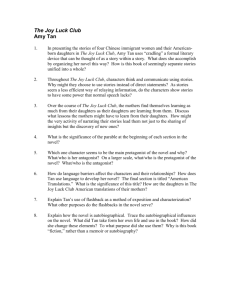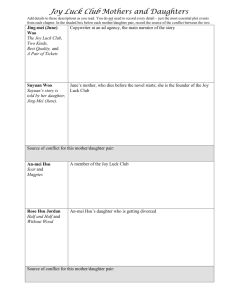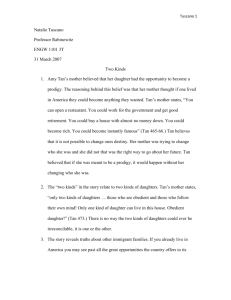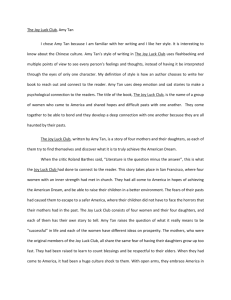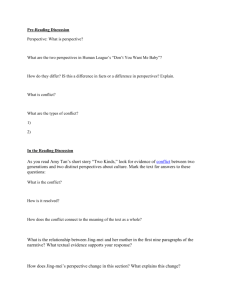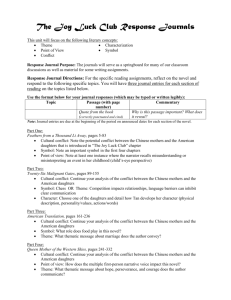GIDNI 2 LITERATURE 420 MOTHER
advertisement
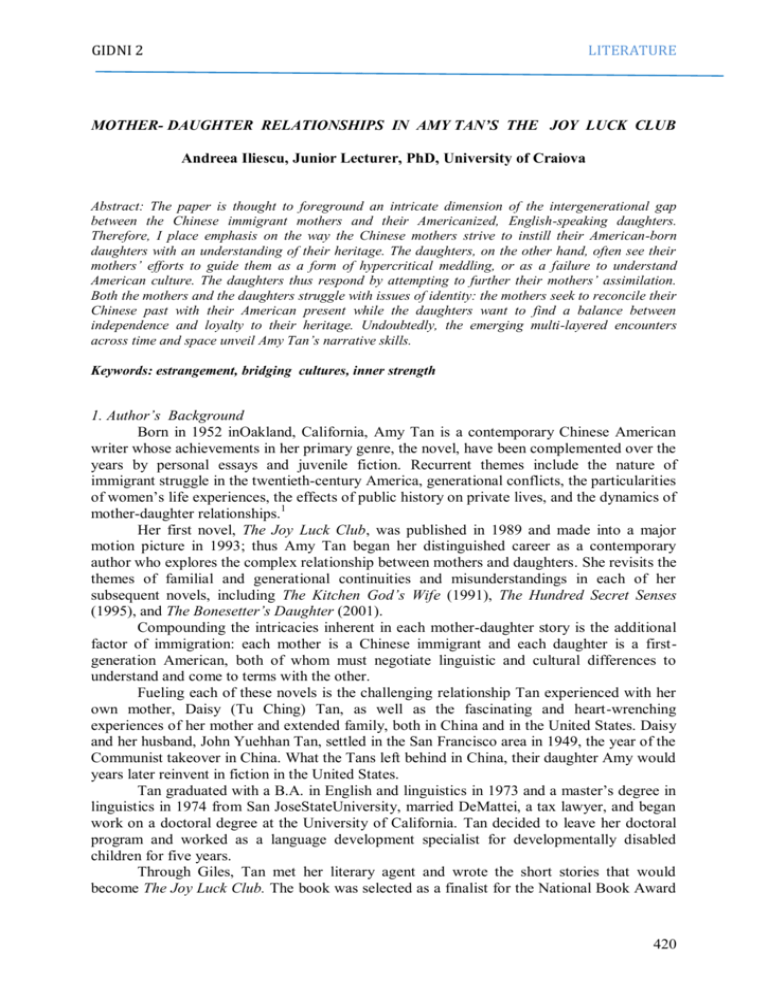
GIDNI 2 LITERATURE MOTHER- DAUGHTER RELATIONSHIPS IN AMY TAN’S THE JOY LUCK CLUB Andreea Iliescu, Junior Lecturer, PhD, University of Craiova Abstract: The paper is thought to foreground an intricate dimension of the intergenerational gap between the Chinese immigrant mothers and their Americanized, English-speaking daughters. Therefore, I place emphasis on the way the Chinese mothers strive to instill their American-born daughters with an understanding of their heritage. The daughters, on the other hand, often see their mothersř efforts to guide them as a form of hypercritical meddling, or as a failure to understand American culture. The daughters thus respond by attempting to further their mothersř assimilation. Both the mothers and the daughters struggle with issues of identity: the mothers seek to reconcile their Chinese past with their American present while the daughters want to find a balance between independence and loyalty to their heritage. Undoubtedly, the emerging multi-layered encounters across time and space unveil Amy Tanřs narrative skills. Keywords: estrangement, bridging cultures, inner strength 1. Authorřs Background Born in 1952 inOakland, California, Amy Tan is a contemporary Chinese American writer whose achievements in her primary genre, the novel, have been complemented over the years by personal essays and juvenile fiction. Recurrent themes include the nature of immigrant struggle in the twentieth-century America, generational conflicts, the particularities of women‘s life experiences, the effects of public history on private lives, and the dynamics of mother-daughter relationships.1 Her first novel, The Joy Luck Club, was published in 1989 and made into a major motion picture in 1993; thus Amy Tan began her distinguished career as a contemporary author who explores the complex relationship between mothers and daughters. She revisits the themes of familial and generational continuities and misunderstandings in each of her subsequent novels, including The Kitchen Godřs Wife (1991), The Hundred Secret Senses (1995), and The Bonesetterřs Daughter (2001). Compounding the intricacies inherent in each mother-daughter story is the additional factor of immigration: each mother is a Chinese immigrant and each daughter is a firstgeneration American, both of whom must negotiate linguistic and cultural differences to understand and come to terms with the other. Fueling each of these novels is the challenging relationship Tan experienced with her own mother, Daisy (Tu Ching) Tan, as well as the fascinating and heart-wrenching experiences of her mother and extended family, both in China and in the United States. Daisy and her husband, John Yuehhan Tan, settled in the San Francisco area in 1949, the year of the Communist takeover in China. What the Tans left behind in China, their daughter Amy would years later reinvent in fiction in the United States. Tan graduated with a B.A. in English and linguistics in 1973 and a master‘s degree in linguistics in 1974 from San JoseStateUniversity, married DeMattei, a tax lawyer, and began work on a doctoral degree at the University of California. Tan decided to leave her doctoral program and worked as a language development specialist for developmentally disabled children for five years. Through Giles, Tan met her literary agent and wrote the short stories that would become The Joy Luck Club. The book was selected as a finalist for the National Book Award 420 GIDNI 2 LITERATURE for Fiction and the National Book Critics Circle Award. The novel stayed on the New York Times best-seller list for almost a year and has been translated into more than 20 languages. She has since published four more novels, The Kitchen Godřs Wife (1991), The Hundred Secret Senses (1995), The Bonesetterřs Daughter (2001), and Saving Fish from Drowning (2005). Her work is both critically and popularly acclaimed. E.D. Huntley2 underscores the fact that Amy Tan, an American writer of Chinese descent tackles a wealth of literary subjects, drawing on her Chinese heritage and beyond. As a writer whose background includes Chinese tradition, Western Protestantism, American and Swiss education, experience in business writing, extensive readings in contemporary fiction, but more importantly the hyphenated condition common to all Americans of recent ethnic derivation, Amy Tan shares a number of common concerns and themes with other Asian American3 writers. Like them, she writes about the liminal identity of the hyphenated American, about the cultural chasm between immigrant parents and their American-born offspring and the linguistic gaps between generations, and finally about the need to discover a usable and recognizable past. But she does not write exclusively about the Asian experience, nor is her style specifically and wholly Asian despite its frequent allusions to traditional Chinese folk genres and its borrowings from the talk-story tradition. (Bloom, 2009: 54) In her novels, Tan treats themes of complex and multifaceted familial ties –most often between mother and daughter, but sometimes between other family members […] She often employs various characters‘ voices to tell different parts of each story, and so her novels are layered with diverse interpretations of similar events in each character‘s life. The landscape of the novels moves from the United States to China and back again, and the time periods involved generally span several lifetimes, reaching from the present back to the pre-World War II era. Tan resists being labeled an ethnic writer, preferring to recognize her novels as ―American‖ rather than representative of Chinese culture. Her characters‘ issues are the issues of all men and women, not only those who are born Chinese. Through each novel, Tan‘s connection to her mother‘s life story is evident, and her mother‘s gift for storytelling is indelibly preserved.4 2.Mothers and Daughters Reaching Out to Each Other In Amy Tan‘s internationally best-selling and well reviewed first novel, The Joy Luck Club (1989), the story revolves around four sets of mother-daughter pairs. The correspondences and continuities between the immigrant Chinese mothers and their firstgeneration American daughters overshadow the superficial differences that each pair experiences as they learn to deal with the intricacies of negotiating two very different cultures. Originally conceived by Tan as a series of short stories, the intertwined lives of the mothers and daughters form a fully fashioned novel that won critical and popular acclaim. The novel is divided into four sections, and the stories in each section are linked thematically. While the novel as a whole deals with Jing-mei ―June‖ Woo‘s emotional discovery of her mother‘s life through the stories of the women of the Joy Luck Club after her mother‘s death, each character in the story uncovers a closer link to her own mother or daughter through storytelling. The novel moves effortlessly from present-day California to wartime China and back again, focusing on the individual events in each woman‘s life to provide cohesion. The mothers, working within an intensely patriarchal system, use their own ingenuity to carve out lives for themselves, eventually reinventing themselves in a new country. Their fondest wish is that their American-born daughters, raised in a land of opportunity, would be able to appreciate the sacrifices their mothers had made for them and to live fulfilling, 421 GIDNI 2 LITERATURE satisfying lives. The daughters, exposed from birth to two cultures, struggle between the dominant public American culture that informs so much of their lives and the formative private Chinese culture -incarnate in their mothers- that they feel compelled to rebel against or maintain privately. Throughout the story cycles, the mothers‘ and daughters‘ voices begin to intermingle until a continuity forms between the pairs, and the fragmented experiences that each daughter thought were unique to her become whole within the narrative of her mother. Each mother‘s strength, exhibited in the actions she took in her own life and the lessons she learned from them, spills over to ameliorate and complete her daughter‘s experiences. Using eight different points of view in the novel, Amy Tan resolves the narrative with June‘s reunion in China with her long-lost sisters. During the meeting, each daughter feels the presence of her mother, and several generations are united. To accomplish the unity of the novel, Amy Tan relies on recurring symbols such as the mah-jong table, with its four sides, four players, and four directions that hint at the multiplicity of interpretations available for each story. Other unifying devices include the difficulty each woman has with language and culture, as exemplified in several stories by the food each woman prepares and eats. As Tan links the tales and then weaves them into the whole that constitutes the novel, her poetic ability to reconcile opposites and draw meaning out of each aspect of life becomes as moving as the lives she creates. 5 The Joy Luck Club earned much critical praise for its emotional honesty and the freshness of its vision. The novel also proved to have the popular appeal required for best seller status. Vintage Books purchased the paperback reprinting rights for $1.2 million in an auction that involved nine publishing houses. The text portrayed a heterogeneous array of Asian American maternal-filial relationship, helping to tackle stereotypes about Asian and Asian American women as submissive, weak, passive, inarticulate, and silent. Structurally, The Joy Luck Club is comprised of interconnected vignettes that deal with the life stories of Chinese immigrant mothers and their American-born daughters. The mothers‘ stories (those of Suyuan Woo, Lindo Jong, An-mei Hsu, and Ying-ying St. Clair) simultaneously engage, parallel, and contrast those of the daughters (Jing-mei Woo, Waverly Jong, Rose Hsu, and Lena St. Clair, respectively). The parallelism in narrative structure makes for a pattern of articulation and response not unlike a dialogue across planes of space, time, place, and age. This intermingling occurs between dissimilar but ultimately concordant voices. Tan eschews any global extra-diegetic frame in the arrangement and relation of her sixteen stories. ―The Joy Luck Club‖ does function as a thematic frame which introduces the novel‘s central characters and its preoccupation with narrativity and time, but this tale exists on the same diegetic level as the other fifteen, as one story among many. There is no single space in which all of the tales are told, no dramatic circumstance in which the characters might hear one another‘s stories. Each story instead bears its own separate narrative frame; most if not all of the tales appear to be internal monologues, rehearsed but never spoken. (Bloom, 2009: 96) 6 At the center of the text lies a frame story involving the struggle of Jing-mei (June) Woo to reconcile the recent death of her mother with the news that the twin daughters Suyuan left behind in wartime China are actually alive. The Joy Luck Club contains sixteen interwoven stories about conflicts between Chinese immigrant mothers and their American-raised daughters. Melanie McAlister7 emphasizes how the mothers‘ stories perform a reconciliatory function within the broader context of reconfiguring a mother-daughter relationship: For both mothers and daughters, then, these interacting tales are the response, the insistence that silence be replaced by the battle for subjectivity. Once the stories of the past are 422 GIDNI 2 LITERATURE told, the younger generation can no longer see their mothers as artifacts, as misfits, whose unaccountable ―craziness‖ makes their young American lives miserable. The breaking of the silence through stories positions the mothers as subjects of their own histories; in so doing, it restructures the relationship between mother and daughter. (Bloom, 2009: 12) The book hinges on Jing-mei‘s trip to China to meet her half-sisters, twins Chwun Yu and Chwun Hwa. The half-sisters remained behind in China because Jing-mei‘s mother, Suyuan, was forced to leave them on the roadside during her desperate flight from Japan‘s invasion of Kweilin during World War II. Jing-mei was born to a different father years later, in America. Suyuan intended to return to China for her other daughters, but failed to find them before her death. Jing-mei has taken her mother‘s place playing mah-jong in a weekly gathering her mother had organized in China and revived in San Francisco: the Joy Luck Club. The club‘s other members-Lindo, Ying-ying, and An-mei- are three of her mother‘s oldest friends and fellow immigrants. They tell Jing-mei that just before Suyuan died, she had finally succeeded in locating the address of her lost daughters. The three women repeatedly urge Jing-mei to travel to China and tell her sisters about their mother‘s life. But Jing-mei wonders whether she is capable of telling her mother‘s story, and the three older women fear that Jing-mei‘s doubts may be justified. They fear that their own daughters, like Jing-mei, may not know or appreciate the stories of their mothers‘ lives. Undoubtedly Tan‘s characters essentialize each other in a way that inhibits the intergenerational relationship in particular […] To some extent, this situation is countered formally, through both the novel‘s multiple narrators and talk-story. It features talk-stories by and about different generations of women consistent with Kingston‘s The Woman Warrior. (Adams, 2008: 126) In the first four stories of the book, the mothers, speaking in turn, recall with astonishing clarity their relationships with their own mothers, and they worry that their daughters‘ recollections of them will never possess the same intensity. In the second section, these daughters- Waverly, Jing-mei, Lena, and Rose-relate their recollections of their childhood relationships with their mothers; the great lucidity and force with which they tell their stories prove their mothers‘ fears at least partially unfounded. In the third group of stories, the four daughters narrate their adult dilemmas- troubles in marriage and with their careers. Although they believe that their mothers‘ antiquated ideas do not pertain to their own very American lifestyles, their search for solutions inevitably brings them back to their relationships with the older generation. In the final group of stories, the mothers struggle to offer solutions and support to their daughters, in the process learning more about themselves. Lindo recognizes through her daughter, Waverly, that she has been irrevocably changed by American culture. Ying-ying realizes that Lena has unwittingly followed her passive example in her marriage to Harold Livotny. An-mei realizes that Rose has not completely understood the lessons she intended to teach her about faith and hope. Referring to the intricate fabric of the novel, to the multiple points of view as well as to the shifting perspective in time and across space, Bella Adams claims that ―In some respects, The Joy Luck Club lends support to this argument about interchangeability because its complex form – sixteen stories, four parts, and two generations of narrators, when coupled with narratives that move back and forth in time and across continents without any apparent concern for order[…]‖8 lead to an obvious uncertainty about who is who. In a way, Jing-mei Woo is the main character of The Joy Luck Club. Structurally, her narratives serve as bridges between the two generations of storytellers, as Jing-mei speaks both for herself and for her recently deceased mother, Suyuan. Jing-mei also bridges America and China. When she travels to China, she discovers the Chinese essence within herself, thus 423 GIDNI 2 LITERATURE realizing a deep connection to her mother that she had always ignored. She also brings Suyuan‘s story to her long-lost twin daughters, and, once reunited with her half-sisters, gains an even more profound understanding of who her mother was. For the most part, Jing-mei‘s fears echo those of her peers, the other daughters of the Joy Luck Club members. They have always identified with Americans (Jing-mei also goes by the English name, June) but are beginning to regret having neglected their Chinese heritage. Her fears also speak to a reciprocal fear, shared by the mothers, who wonder whether, by giving their daughters American opportunities and self-sufficiency, they have alienated them from their Chinese heritage. Jing-mei is representative in other ways as well. She believes that her mother‘s constant criticism bespeaks a lack of affection, when in fact her mother‘s severity and high expectations are expressions of love and faith in her daughter. The chapter ―The Joy Luck Club‖ offers us more than a few glimpses of how Jing-mei and her mother used to interact: The elements were from my mother‘s own version of organic chemistry. Each person is made of five elements, she told me. Too much fire and you had a bad temper. That was like my father, whom my mother always criticized for his cigarette habit and who always shouted back that she should keep her thoughts to herself. I think he now feels guilty that he didn‘t let my mother speak her mind. Too little wood and you bent too quickly to listen to other people‘s ideas, unable to stand on your own. This was like my Auntie An –mei. Too much water and you flowed in too many directions, like myself, for having started half a degree in biology, then half a degree in art, and then finishing neither when I went off to work for a small ad agency as a secretary, later becoming a copywriter. (Tan: The Joy Luck Club)9 All of the other mother-daughter pairs experience the same misunderstanding, which in some way may be seen to stem from cultural differences. What Tan portrays as the traditional Chinese values of filial obedience, criticism-enveloped expressions of love, and the concealment of excessive emotions all clash with the daughters‘ ―American‖ ideas about autonomy, free and open speech, and self-esteem. However, by eventually creating a bridge between China and America, between mothers and daughters, Jing-mei ultimately reconciles some of these cultural and generational differences, providing hope for the other motherdaughter pairs. Suyuan Woo is a strong and willful woman who refuses to focus on her hardships. Instead, she struggles to create happiness and success where she finds it lacking. It is with this mentality that she founds the original Joy Luck Club while awaiting the Japanese invasion of China in Kweilin. Her sense of the power of will can at times cause problems, such as when Suyuan believes that her daughter Jing-mei can be a child prodigy if only the Woos can locate her talent and nurture it well enough. This leads to a deep resentment in Jing-mei. The chapter ―Two Kinds‖ uncovers an arduous relationship between mother and daughter, misperceived by Jing-mei as an unceasing effort on her mother‘s behalf to put more strain of her daughter‘s life. Therefore, Jing-mei repeatedly fails to understand her mother‘ high expectations as what they really were, meaning the most sincere proof of her love for her daughter: My mother believed you could be anything you wanted to be in America. You could open a restaurant. You could work for the government and get good retirement. You could buy a house with almost no money down. You could become rich. You could become instantly famous. ―Of course you can be prodigy, too,‖ my mother told me when I was nine. ―You can be best anything. What does Auntie Lindo know? Her daughter, she is only best tricky.‖ 424 GIDNI 2 LITERATURE America was where all my mother‘s hopes lay. She had come here in 1949 after losing everything in China: her mother and father, her family home, her first husband, and two daughters, twin baby girls. But she never looked back with regret. There were so many ways for things to get better. (Tan: The Joy Luck Club) Yet it is also by virtue of Suyuan‘s will that she eventually locates her long-lost twin daughters in China. Only her death prevents her from returning to them. Suyuan shares many characteristics with her fellow mothers in the Joy Luck Club: fierce love for her daughter, often expressed as criticism; a distress at her daughter‘s desire to shake off her Chinese identity in favour of an American one; and a fear that she may be alienated from her daughter either because of her own actions or because of their divergent ages and cultural upbringings. At an early age, An-mei Hsu learns lessons in stoic and severe love from her grandmother, Popo, and from her mother. Her mother also teaches her to swallow her tears, to conceal her pain, and to distrust others. Although An-mei later learns to speak up and assert herself, she fears that she has handed down a certain passivity to her daughter, Rose. An-mei sees ―fate‖ as what one is ―destined‖ to struggle toward achieving. When her youngest child, Bing, dies, An-mei ceases to express any outward faith in God, but retains her belief in the force of will. Rose initially believed that the death had caused her mother to lose faith altogether, but she eventually realizes that she may have misinterpreted her mother‘s behaviour. Rose Hsu Jordan finds herself unable to assert her opinions, to stand up for herself, or to make decisions. The chapter ―Without Wood‖ addresses the adult dilemmas that Rose Hsu Jordan is facing: My mother once told me why I was so confused all the time. She said I was without wood. Born without wood so that I listened to too many people. She knew this, because once she had almost become this way. ―A girl is like a young tree,‖ she said. ―You must stand tall and listen to your mother standing next to you. That is the only way to grow strong and straight. But if you bend to listen to other people, you will grow crooked and weak. You will fall to the ground with the first strong wind. And then you will be like a weed, growing wild in any direction, running along the ground until someone pulls you out and throws you away.‖ (Tan: The Joy Luck Club) Although she once displayed a certain strength, illustrated by her insistence on marrying her husband, Ted, despite her mother‘s objections and her mother-in-law‘s poorly concealed racism, she has allowed herself to become the ―victim‖ to Ted‘s ―hero,‖ letting him to make all of the decisions in their life together. She finally needs her mother‘s intervention in order to realize that to refuse to make decisions is in fact itself a decision: a decision to continue in a state of subservience, inferiority, and ultimate unhappiness. Rose‘s youngest brother, Bing, died when he was four years old. Because Bing drowned at the beach while Rose was supposed to be watching him, Rose feels responsible for his death, despite the fact that the rest of the family does not hold Rose accountable. Her refusal to take on future responsibilities may stem from her fear of future blame should misfortunes occur. Lindo Jong learns from an early age the power of ―invisible strength‖- of hiding one‘s thoughts until the time is ripe to reveal them, and of believing in one‘s inner force even when one finds oneself at a disadvantage. She discovers these values while in China, caught in a loveless marriage and oppressed by the tyranny of her mother-in-law. By playing upon her mother-in-law‘s superstition and fear, Lindo eventually extricates herself from the marriage with her dignity intact, and without dishonoring her parents‘ promise to her husband‘s family. 425 GIDNI 2 LITERATURE Lindo later teaches these skills of invisible strength- for which she uses the wind as a metaphor-to her daughter, Waverly. Her lessons nurture Waverly‘s skill at chess, but Waverly comes to resent her mother‘s control and seeming claims of ownership over her successes. Eventually, Waverly seems to become ashamed of Lindo and misunderstands her as a critical, controlling, and narrow-minded old woman. Lindo perhaps experiences the largest crisis of cultural identity of any of the characters. She regrets having wanted to give Waverly both American circumstances and a Chinese character, stating that the two can never successfully combine. She thinks that from the moment she gave Waverly an American name- she named her after the street where the family lived- she has allowed her daughter to become too American, and consequently contributed to the barrier that separates them. At the same time, however, she recognizes her own American characteristics and knows that she is no longer ―fully Chinese‖: during her recent visit to China, people recognized her as a tourist. Distressed by this, Lindo wonders what she has lost by the alteration. Her strategies of concealing inner powers and knowledge may be related to her ability to maintain what Waverly characterizes as a type of ―twofacedness‖- an ability to switch between a ―Chinese‖ and an ―American‖ face depending on whom she is with. From her mother, Waverly inherits her ―invisible strength‖- her ability to conceal her thoughts and strategize. Although she applies these to chess as a child, she later turns them on her mother, Lindo, as well, imagining her struggles with her mother as a tournament. Waverly‘s focus on invisible strength also contributes to a sense of competitiveness: she feels a rivalry with Jing-mei and humiliates her in front of the others at Suyuan‘s New Year‘s dinner. Yet Waverly is not entirely self-centered: she loves her daughter, Shoshana, unconditionally. Nor is she without insecurities: she fears her mother‘s criticism of her fiancé, Rich. In fact, it seems that Waverly tends to project her fears and dislikes onto her mother. As she sits through dinner with her parents and Rich, she becomes distraught as she imagines her mother‘s growing hatred of her fiancé. Yet, later on, she realizes that her mother in fact likes Rich. Waverly was the one with the misgivings, perhaps a sort of cultural guilt: Rich is white, and Waverly does not like to think that she has lost her ties to her Chinese heritage. Ying-ying was born in the year of the Tiger, a creature of force and stealth. However, when her nursemaid tells her that girls should be meek and passive, Ying-ying begins to lose her sense of autonomous will. Furthermore, at an early age, Ying-ying‘s profound belief in fate and her personal destiny led to a policy of passivity and even listlessness. Always listening to omens and signs, she never paid attention to her inner feelings. Because she believed that she was ―destined‖ to marry a vulgar family friend, she did nothing to seriously prevent the marriage, and even came to love her husband, as if against her will. When he died, she allowed the American Clifford St. Clair to marry her because she sensed that he was her destiny as well. For years, she let Clifford mistranslate her clipped sentences, her gestures, and her silences. Melanie McAlister10 illustrates the power of storytelling through Ying-ying St. Clair‘s determination to prevent her daughter, Lena from following in her footsteps, turning herself into a sheer example of passivity and subservience: A reading of the mother-daughter stories as a counter to Orientalist assimilationism can be sustained at the level of content as well as form. In The Joy Luck Club, the silence of Asian and Asian American women is broken: stories are told, subjectivity is constructed. Tan attempts a collective story – a narration that moves into the voice of the mothers, which allows them to speak for and re-contextualize themselves. In the United States, the mothers have been silenced by the language barrier, by the cultural prejudices and the racism that render them ―outside,‖ and ineffective. Through the telling of these stories, the subaltern speaks. And in 426 GIDNI 2 LITERATURE speaking, she rewrites herself, in all her specificity and individuality, into a new position vis-àvis both her daughters and the dominant discourse around her. (Bloom, 2009: 10) Only after Ying-ying realizes that she has passed on her passivity and fatalism to her daughter, Lena, does she take any initiative to change. Seeing her daughter in an unhappy marriage, she urges her to take control. She tells Lena her story for the first time, hoping that she might learn from her mother‘s own failure to take initiative and instead come to express her thoughts and feelings. Lena, too, was born in the year of the Tiger, and Ying-ying hopes that her daughter can live up to their common horoscope in a way that she herself failed to do. Moreover, in this belief in astrology Ying-ying finds a sort of positive counterpart to her earlier, debilitating superstitions and fatalism, for it is a belief not in the inevitability of external events but in the power of an internal quality. Lena St. Clair is caught in an unhappy marriage to Harold Livotny. Harold insists that the couple keep separate bank accounts and use a balance sheet to detail their monetary debts to one another. Although he believes that this policy will keep money out of the relationship, it in fact accomplishes the opposite, making money and obligation central to Lena and Harold‘s conjugal life. Lena has inherited her mother Ying-ying‘s belief in superstition and deems herself incapable of reversing what is ―fated‖ to happen. She fails to take initiative to change her relationship, despite her recognition of its dysfunctional elements. While still a child, Lena learns an important lesson from her neighbours. She constantly hears the mother and daughter in the adjacent apartment yelling, fighting, and even throwing things. She is shocked by the difference between these noisy confrontations and her own relationship with her mother, which is marked by silences and avoidance of conflict. Yet, when she realizes that the shouting and weeping she hears through the wall in fact express a kind of deep love between mother and daughter, she realizes the importance of expressing one‘s feelings, even at the cost of peace and harmony. Although the neighbouring family lives a life of conflict and sometimes even chaos, they possess a certainty of their love for each other that Lena feels to be lacking in her own home. Reflecting back on this episode of her life, Lena begins to realize how she might apply the lesson she learned then to her married life with Harold. 3. Conclusion Amy Tan‘s The Joy Luck Club revolves mainly around mothers and daughters, reaching out to each other.Daughters Jing-mei Woo, Rose Hsu Jordan, Waverly Jong, and Lena St. Clair together with their mothers Suyuan Woo, An-mei Hsu, Lindo Jong, and Yingying St. Clair set the stage for a demanding process of negotiation of both their past and their present. Amy Tan‘s characters are not depicted as engaging in a proper dialogue meant to bring them together, once they have managed to cope with whatever misunderstandings permeated their relationships. More like, they approach their acknowledged communication issues through elaborate monologues, unveiling unexpected points of view in the light of remapping reality in accordance with heart-wrenching memories and sorrowful life lessons. Acknowledgments This work was supported by the strategic grant POSDRU/159/1.5/S/133255, Project ID 133255 (2014), co-financed by the European Social Fund within the Sectorial Operational Program Human Resources Development 2007-2013. NOTES: 1 Guiyou Huang (Ed.) The Greenwood Encyclopedia of Asian American Literature (Vols. 1-3). Westport, CT: Greenwood Press, 2009, p. 906 427 GIDNI 2 LITERATURE E.D. Huntley. Amy Tan and Asian American Literature. In: Bloomřs Modern Critical Views: AsianAmerican writers. New Edition, editor Harold Bloom. New York, NY: Infobase Publishing, 2009, p. 54 3 Guiyou Huang (Ed.) The Greenwood Encyclopedia of Asian American Literature (Vols. 1-3). Westport, CT: Greenwood Press, 2009, p. 42: ŖThe increasing globalization and transnational activities 2 bring about more diversity in the Asian American population and community. Before World War II, Asian Americans consisted mainly of immigrants from China, Japan, and the Philippines, including a small number from Korea and India. Recently, the population of Asian Americans in the United States has increased to over 1.2 million, including immigrants from more than 20 Asian countries or regions. Asian American is a term used today to refer to all Asian immigrants, inhabitants, or American-born citizens of Asian origins. The term came into being in the late 1960s in the wake of the Asian American movement. […] In 1968 a group of activists of the Asian American movement in Berkeley founded the Asian American Political Association. Unsatisfied with the prevailing tem Oriental, which was used to designate the category of Americans with Asian origins, these activists coined Asian American as a counterblast. Unlike the prevailing word Oriental, which signified a caricatured image of submissiveness and periphery, Asian American cultivated a sense of ethnic unity that was tied to a neither American nor Asian cultural awareness. The term was later accepted by American official institutions and applied in the population census of 1980.ŗ 4 Seiwoong Oh. Encyclopedia of Asian-American Literature.New York, NY: Facts on File, Inc., 2007, pp. 281-2 5 Ibidem, pp. 141-2 6 Marc Singer. Moving Forward to Reach the Past: The Dialogics of Time in Amy Tanřs The Joy Luck Club. In: In Bloomřs Modern Critical Interpretations: The Joy Luck Club. New Edition, editor Harold Bloom. New York, NY: Infobase Publishing, p. 96 7 Melanie McAlister. (Mis) Reading The Joy Luck Club. In: Bloomřs Modern Critical Views: Amy Tan. New Edition, editor Harold Bloom. New York, NY: Infobase Publishing, 2009, p. 12 8 Bella Adams. Identity-in-Difference:Re-generating Debate about Intergenerational Relationships in Amy Tanřs The Joy Luck Club. In Bloomřs Modern Critical Interpretations: The Joy Luck Club. New Edition, editor Harold Bloom. New York, NY: Infobase Publishing, p. 126 9 http://bookzz.org/book/1442853/13328b, Amy Tan . The Joy Luck Club, retrieved January 20, 2015. All references in the text are to this edition. 10 Melanie McAlister. (Mis) Reading The Joy Luck Club. In: Bloomřs Modern Critical Views: Amy Tan. New Edition, editor Harold Bloom. New York, NY: Infobase Publishing, 2009, p. 10-11 BIBLIOGRAPHY: Adams, B. Asian American literature.Edinburgh: Edinburgh University Press Ltd., 2008 Bloom, H. (Ed.). Bloomřs Modern Critical Views: Asian-American writers. New Edition. New York, NY: Infobase Publishing, 2009 _________ Bloomřs Modern Critical Views: Amy Tan. New Edition. New York, NY: Infobase Publishing, 2009 _________ Bloomřs Modern Critical Interpretations: The Joy Luck Club. New Edition. New York, NY: Infobase Publishing, 2009 Darraj, S. M. Asian Americans of achievement. Amy Tan.New York, NY: Infobase Publishing, 2007 Grice, H. Negotiating identities. An introduction to Asian American womenřs writing.Manchester: ManchesterUniversity Press, 2002 Huang, Guiyou. The Columbia guide to Asian American literature since 1945.New York, NY: ColumbiaUniversity Press, 2006 ________ The Greenwood encyclopedia of Asian American literature (Vols. 1-3). Westport, CT: Greenwood Press, 2009 Leonard, G. J. (Ed.) The Asian Pacific American heritage: A companion to literature and arts.New York, NY: Garland Publishing, Inc., 2005 428 GIDNI 2 LITERATURE 10) Oh, Seiwoong. Encyclopedia of Asian-American literature.New York, NY: Facts on File, Inc., 2007 Internet. Webpage http://bookzz.org/book/1442853/13328b, Tan, Amy. The Joy Luck Club, retrieved January, 20, 2015 429
